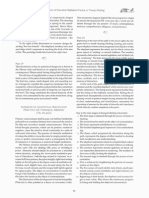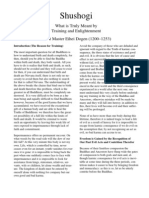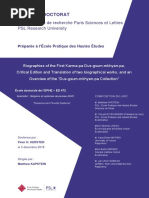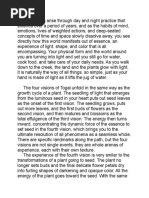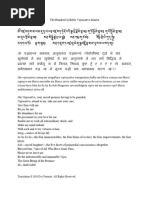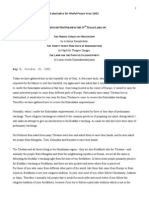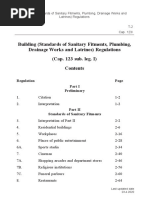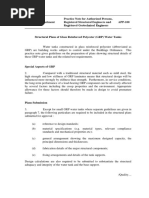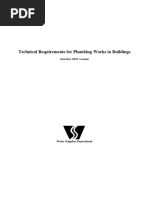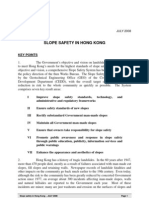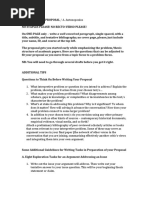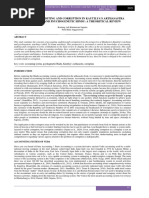0 ratings0% found this document useful (0 votes)
67 viewsJoyfulPath 23 TranquilAbiding
JoyfulPath 23 TranquilAbiding
Uploaded by
clementmwwong6387The document outlines how to train the mind in tranquil abiding meditation, which is the essence of concentration. It details the necessary conditions for attaining tranquil abiding such as having a suitable place and little distraction. It then describes the five obstacles to tranquil abiding like laziness and forgetfulness, and the eight opponents to overcome these obstacles including faith, effort and mindfulness. Finally, it explains how to attain the nine mental abidings that are the stages of tranquil abiding meditation.
Copyright:
Attribution Non-Commercial (BY-NC)
Available Formats
Download as PDF, TXT or read online from Scribd
JoyfulPath 23 TranquilAbiding
JoyfulPath 23 TranquilAbiding
Uploaded by
clementmwwong63870 ratings0% found this document useful (0 votes)
67 views2 pagesThe document outlines how to train the mind in tranquil abiding meditation, which is the essence of concentration. It details the necessary conditions for attaining tranquil abiding such as having a suitable place and little distraction. It then describes the five obstacles to tranquil abiding like laziness and forgetfulness, and the eight opponents to overcome these obstacles including faith, effort and mindfulness. Finally, it explains how to attain the nine mental abidings that are the stages of tranquil abiding meditation.
Original Title
JoyfulPath_23_TranquilAbiding
Copyright
© Attribution Non-Commercial (BY-NC)
Available Formats
PDF, TXT or read online from Scribd
Share this document
Did you find this document useful?
Is this content inappropriate?
The document outlines how to train the mind in tranquil abiding meditation, which is the essence of concentration. It details the necessary conditions for attaining tranquil abiding such as having a suitable place and little distraction. It then describes the five obstacles to tranquil abiding like laziness and forgetfulness, and the eight opponents to overcome these obstacles including faith, effort and mindfulness. Finally, it explains how to attain the nine mental abidings that are the stages of tranquil abiding meditation.
Copyright:
Attribution Non-Commercial (BY-NC)
Available Formats
Download as PDF, TXT or read online from Scribd
Download as pdf or txt
0 ratings0% found this document useful (0 votes)
67 views2 pagesJoyfulPath 23 TranquilAbiding
JoyfulPath 23 TranquilAbiding
Uploaded by
clementmwwong6387The document outlines how to train the mind in tranquil abiding meditation, which is the essence of concentration. It details the necessary conditions for attaining tranquil abiding such as having a suitable place and little distraction. It then describes the five obstacles to tranquil abiding like laziness and forgetfulness, and the eight opponents to overcome these obstacles including faith, effort and mindfulness. Finally, it explains how to attain the nine mental abidings that are the stages of tranquil abiding meditation.
Copyright:
Attribution Non-Commercial (BY-NC)
Available Formats
Download as PDF, TXT or read online from Scribd
Download as pdf or txt
You are on page 1of 2
The Joyful Path of Good Fortune: Training the Mind in
Tranquil Abiding
This is an outline summarizing the condensed meaning of the chapter “Training the
Mind in Tranquil Abiding” in the book “The Joyful Path of Good Fortune” by Geshe
Kelsang Gyatso (Tharpa Publications, 2nd rev. ed., 1995). It is a restructuring of a
portion of the book's appendix “The Condensed Meaning of the Text.” The square
brackets enclose the outline key (e.g. [4.1.2] would be the second part, of the first part,
of the fourth part).
How to train the mind in tranquil abiding, the essence of
concentration. [4.2.2.3.4.1.2.1] p.482
1. The necessary conditions for attaining tranquil abiding. [4.2.2.3.4.1.2.1.1] p.486
1. A suitable place for retreat. [4.2.2.3.4.1.2.1.1.1]
2. Little desire. [4.2.2.3.4.1.2.1.1.2] p.487
3. Contentment. [4.2.2.3.4.1.2.1.1.3]
4. No distracting activities. [4.2.2.3.4.1.2.1.1.4] p.488
5. Pure moral discipline. [4.2.2.3.4.1.2.1.1.5]
6. No distracting conceptions. [4.2.2.3.4.1.2.1.1.6] p.489
2. How to attain tranquil abiding. [4.2.2.3.4.1.2.1.2] p.489
1. The five obstacles to attaining tranquil abiding. [4.2.2.3.4.1.2.1.2.1] p.490
1. Laziness. [4.2.2.3.4.1.2.1.2.1.1]
2. Forgetfulness. [4.2.2.3.4.1.2.1.2.1.2] p.491
3. Mental sinking and mental excitement. [4.2.2.3.4.1.2.1.2.1.3]
4. Non-application. [4.2.2.3.4.1.2.1.2.1.4] p.493
5. Unnecessary application. [4.2.2.3.4.1.2.1.2.1.5] p.494
2. The eight opponents to the five obstacles. [4.2.2.3.4.1.2.1.2.2] p.494
1. Faith. [4.2.2.3.4.1.2.1.2.2.1]
2. Aspiration. [4.2.2.3.4.1.2.1.2.2.2]
3. Effort. [4.2.2.3.4.1.2.1.2.2.3]
4. Suppleness. [4.2.2.3.4.1.2.1.2.2.4]
5. Mindfulness. [4.2.2.3.4.1.2.1.2.2.5] p.495
6. Alertness. [4.2.2.3.4.1.2.1.2.2.6] p.496
7. Application. [4.2.2.3.4.1.2.1.2.2.7] p.498
8. Non-application. [4.2.2.3.4.1.2.1.2.2.8]
3. How to attain the nine mental abidings. [4.2.2.3.4.1.2.1.2.3] p.500
1. The object of meditation. [4.2.2.3.4.1.2.1.2.3.1] p.500
1. Pervasive objects. [4.2.2.3.4.1.2.1.2.3.1.1] p.501
2. Objects for abandoning individual delusions. [4.2.2.3.4.1.2.1.2.3.1.2]
3. Object for abandoning delusions in general. [4.2.2.3.4.1.2.1.2.3.1.3] p.502
4. Objects for scholars. [4.2.2.3.4.1.2.1.2.3.1.4]
2. The nine mental abidings. [4.2.2.3.4.1.2.1.2.3.2] p.505
1. Placing the mind. [4.2.2.3.4.1.2.1.2.3.2.1]
2. Continual placement. [4.2.2.3.4.1.2.1.2.3.2.2] p.507
3. Replacement. [4.2.2.3.4.1.2.1.2.3.2.3]
4. Close placement. [4.2.2.3.4.1.2.1.2.3.2.4] p.508
5. Controlling. [4.2.2.3.4.1.2.1.2.3.2.5]
6. Pacifying. [4.2.2.3.4.1.2.1.2.3.2.6]
7. Completely pacifying. [4.2.2.3.4.1.2.1.2.3.2.7]
8. Single-pointedness. [4.2.2.3.4.1.2.1.2.3.2.8] p.509
9. Placement in equipoise. [4.2.2.3.4.1.2.1.2.3.2.9]
4. The six forces. [4.2.2.3.4.1.2.1.2.4] p.509
1. The force of listening. [4.2.2.3.4.1.2.1.2.4.1]
2. The force of contemplating. [4.2.2.3.4.1.2.1.2.4.2]
3. The force of mindfulness. [4.2.2.3.4.1.2.1.2.4.3]
4. The force of alertness. [4.2.2.3.4.1.2.1.2.4.4]
5. The force of effort. [4.2.2.3.4.1.2.1.2.4.5]
6. The force of complete familiarity. [4.2.2.3.4.1.2.1.2.4.6]
5. The four attentions. [4.2.2.3.4.1.2.1.2.5] p.511
1. Tight attention. [4.2.2.3.4.1.2.1.2.5.1]
2. Interrupted attention. [4.2.2.3.4.1.2.1.2.5.2]
3. Uninterrupted attention. [4.2.2.3.4.1.2.1.2.5.3]
4. Spontaneous attention. [4.2.2.3.4.1.2.1.2.5.4]
6. The measurement of having attained tranquil abiding. [4.2.2.3.4.1.2.1.2.6] p.511
Context
1. Explanation of the pre-eminent qualities of the author, showing that the
instructions of Lamrim are authentic. [1] p.5
2. Explanation of the pre-eminent qualities of Lamrim to inspire faith and respect for
the Lamrim instructions. [2] p.17
3. Explanation of how to listen to and teach Dharma. [3] p.25
4. Explanation of the actual instructions of the stages of the path to
enlightenment. [4] p.39
1. How to rely upon a Spiritual Guide, the root of spiritual paths. [4.1] p.39
2. How to take the essence of our human life. [4.2] p.121
1. How to develop the determination to take the essence of our precious human
life. [4.2.1]
2. Training the mind in the actual methods for taking the essence of our
precious human life. [4.2.2] p.139
1. Training the mind in the stages of the path of a person of initial
scope. [4.2.2.1] p.144
2. Training the mind in the stages of the path of a person of intermediate
scope. [4.2.2.2] p.267
3. Training the mind in the stages of the path of a person of great
scope. [4.2.2.3] p.381
1. Why we need to enter the Mahayana. [4.2.2.3.1]
2. The benefits of bodhichitta. [4.2.2.3.2] p.382
3. How to develop bodhichitta. [4.2.2.3.3] p.394
4. How to engage in a Bodhisattva's actions. [4.2.2.3.4] p.447
1. Training in the six perfections to ripen our own mental
continuum. [4.2.2.3.4.1] p.448
1. The six perfections in general. [4.2.2.3.4.1.1]
2. The perfections of mental stabilization and wisdom in
particular. [4.2.2.3.4.1.2] p.482
1. How to train the mind in tranquil abiding, the essence of
concentration. [4.2.2.3.4.1.2.1]
last updated 2009-08-21
You might also like
- Praise Chords CDocument3 pagesPraise Chords CMark Mutambuka100% (3)
- Crucial Conversation Online ToolkitDocument41 pagesCrucial Conversation Online ToolkitAnonymous MlhE2sa93% (29)
- The Path of The Dark GoddessDocument52 pagesThe Path of The Dark GoddessMariana Alvez Guerra100% (1)
- Precious Garland of The Middle Way ENG 1Document77 pagesPrecious Garland of The Middle Way ENG 1Alina Severino100% (1)
- Shame ErskineDocument17 pagesShame ErskineSonja Sudimac100% (1)
- Buddhahood Beyond The Intellect - FacebookDocument10 pagesBuddhahood Beyond The Intellect - FacebookPavel FenclNo ratings yet
- How To Convert Different Legacy Formats of Tibetan Texts Into Standard Unicode Tibetan - Digital TibetanDocument7 pagesHow To Convert Different Legacy Formats of Tibetan Texts Into Standard Unicode Tibetan - Digital Tibetanlongjim31No ratings yet
- The Jewel Rosary of The BodhisattvasDocument6 pagesThe Jewel Rosary of The BodhisattvasdalotusNo ratings yet
- Help in Developing Aspiring BodhicittaDocument5 pagesHelp in Developing Aspiring Bodhicitta101176No ratings yet
- The Brightly Shining Sun: A Step-by-Step Guide To Meditating On The Bodhicaryavatara - Patrul RinpocheDocument33 pagesThe Brightly Shining Sun: A Step-by-Step Guide To Meditating On The Bodhicaryavatara - Patrul RinpocheLaura GibsonNo ratings yet
- Root Text Dilgo KhyentseDocument20 pagesRoot Text Dilgo Khyentselongjim31100% (2)
- Wheel of Times - December 2020Document16 pagesWheel of Times - December 2020Vincent GuillemotNo ratings yet
- The Sutra and The Life of Bodhisattva KsitigarbhaDocument48 pagesThe Sutra and The Life of Bodhisattva KsitigarbhaCarvalhoNo ratings yet
- AvalokitesvaraDocument13 pagesAvalokitesvaradieplam85No ratings yet
- Funeral Advice For Buddhists in The Tibetan TraditionDocument27 pagesFuneral Advice For Buddhists in The Tibetan TraditionJose LuxorNo ratings yet
- The King of Aspiration Prayers Textual Outline 20220609Document27 pagesThe King of Aspiration Prayers Textual Outline 20220609Dulce BonillaNo ratings yet
- Bodhicitta: Antidotes To Not Understanding How To Achieve EnlightenmentDocument4 pagesBodhicitta: Antidotes To Not Understanding How To Achieve EnlightenmentAlex MuñozNo ratings yet
- Ahimsa-Buddhism and The Vegetarian IdealDocument77 pagesAhimsa-Buddhism and The Vegetarian IdealHan Sang KimNo ratings yet
- Bodhisattva Leadership: The Leadership of Sel Ess Beings: March 2016Document13 pagesBodhisattva Leadership: The Leadership of Sel Ess Beings: March 2016Stoe annNo ratings yet
- Meditations On Guanyin BodhisattvaDocument2 pagesMeditations On Guanyin BodhisattvaNatacha LecamusNo ratings yet
- Dudjom Rinpoche Mahayana Dedication Why and HowDocument10 pagesDudjom Rinpoche Mahayana Dedication Why and HowAnonymous JAJAWt41s100% (1)
- DEVELOPMENTS OF NARA BUDDHISM in Kamakura Japan PDFDocument29 pagesDEVELOPMENTS OF NARA BUDDHISM in Kamakura Japan PDFRafa Pulido MoyanoNo ratings yet
- On Compassion in The Vimalakirti SutraDocument3 pagesOn Compassion in The Vimalakirti SutrakaljanaNo ratings yet
- As Aspirações Do MahamudraDocument64 pagesAs Aspirações Do MahamudratserNo ratings yet
- Agganna SuttaDocument13 pagesAgganna SuttaanwarthaNo ratings yet
- Shamatha Diagram PDFDocument3 pagesShamatha Diagram PDFtnphubk07No ratings yet
- BodhicittaDocument4 pagesBodhicittactan014No ratings yet
- Dzogchen Explorations - Three Postures in ThodgalDocument2 pagesDzogchen Explorations - Three Postures in ThodgalLalo BaezaNo ratings yet
- The Debate Between Sudden and Gradual EnlightenmentDocument16 pagesThe Debate Between Sudden and Gradual EnlightenmentDaveCNo ratings yet
- Can A Buddha Become AngryDocument6 pagesCan A Buddha Become AngryDr Edo ShoninNo ratings yet
- Practice 8 AnswersDocument10 pagesPractice 8 AnswerstantravidyaNo ratings yet
- The Root Text: by Atisha Dipamkarashrijnana (982-1054)Document17 pagesThe Root Text: by Atisha Dipamkarashrijnana (982-1054)Martin SeidenstickerNo ratings yet
- Atisha Key Instructions of The Middle WayDocument2 pagesAtisha Key Instructions of The Middle WayAstus100% (2)
- The Foundation For Good Qualities - Study BuddhismDocument2 pagesThe Foundation For Good Qualities - Study BuddhismKalpa235No ratings yet
- The Transformation of Compassion Meditat PDFDocument6 pagesThe Transformation of Compassion Meditat PDFRobert C HoodNo ratings yet
- Dogen ShushogiDocument4 pagesDogen Shushogirafael_galvez_3No ratings yet
- BodhisDeedsComm GJTegchok Nalanda1993-EdSept05Document463 pagesBodhisDeedsComm GJTegchok Nalanda1993-EdSept05Lars SchievingNo ratings yet
- Commentary On Parting From The Four AttachmentsDocument18 pagesCommentary On Parting From The Four AttachmentsAlenka JovanovskiNo ratings yet
- Fall 2017 - Winter 2018 Catalog: Shambhala Mountain CenterDocument32 pagesFall 2017 - Winter 2018 Catalog: Shambhala Mountain CentersmcwebsiteNo ratings yet
- Easy Paths English VersionDocument138 pagesEasy Paths English VersionPitNo ratings yet
- Analiysis BorobudurDocument10 pagesAnaliysis BorobudurArtika WulandariNo ratings yet
- The Greater Discourse On VoidnessDocument17 pagesThe Greater Discourse On VoidnessBuddhist Publication SocietyNo ratings yet
- Encyclopedia of Indian Religions. Springer, Dordrecht: Jbapple@ucalgary - CaDocument17 pagesEncyclopedia of Indian Religions. Springer, Dordrecht: Jbapple@ucalgary - CazhigpNo ratings yet
- Loving-Kindness-Meditation-Script-Pema-Chodron MaitriDocument3 pagesLoving-Kindness-Meditation-Script-Pema-Chodron MaitriGabriela Noemi SparnochiaNo ratings yet
- Excerpts From Teaching by Lingtrul RinpocheDocument24 pagesExcerpts From Teaching by Lingtrul RinpocheMary Pat Smeltzer Thompson100% (1)
- Modern Kadampa BuddhismDocument16 pagesModern Kadampa BuddhismDoug KelshawNo ratings yet
- Biographies of The First Karma-Pa Dus-Gsum-Mkhyen-Pa'i Tshogs Chos 2018PSLEP055 - ArchivageDocument381 pagesBiographies of The First Karma-Pa Dus-Gsum-Mkhyen-Pa'i Tshogs Chos 2018PSLEP055 - ArchivagealadinspaceNo ratings yet
- The Question of Maitreya - 84000Document40 pagesThe Question of Maitreya - 84000Tom100% (1)
- Olds @Document3 pagesOlds @rangdroll dzogchenrime100% (1)
- 2.1 TilopaDocument3 pages2.1 TilopaallandzxNo ratings yet
- Fourth Panchen Lama Sadhana Based On Tsong Khapa Three Principal Aspects of The Path 023Document164 pagesFourth Panchen Lama Sadhana Based On Tsong Khapa Three Principal Aspects of The Path 023John CicchinoNo ratings yet
- NyingmaDocument19 pagesNyingmaTsu-Ching YuNo ratings yet
- Serlingpa Leveling OutDocument2 pagesSerlingpa Leveling OuttantravidyaNo ratings yet
- Vajrasattva Mantra Translation Word by WordDocument2 pagesVajrasattva Mantra Translation Word by Wordprincetamang04No ratings yet
- VajrasattvaDocument8 pagesVajrasattvaarpitaNo ratings yet
- Dalai Lama Kalachakra Teachings Day 1Document21 pagesDalai Lama Kalachakra Teachings Day 1JohnIGodis0100% (1)
- The Nectar of Manjushri S Speech A Detailed Commentary On Shantideva S Way of The Bodhisattva 1st Ed. Edition Kunzang Pelden 2024 Scribd DownloadDocument60 pagesThe Nectar of Manjushri S Speech A Detailed Commentary On Shantideva S Way of The Bodhisattva 1st Ed. Edition Kunzang Pelden 2024 Scribd Downloadmekueever100% (12)
- Sutra Copying IntroductionDocument11 pagesSutra Copying IntroductionDavid SantamarinaNo ratings yet
- Retreat and Solitude Collection - LotsawaHouseDocument24 pagesRetreat and Solitude Collection - LotsawaHousedanrvaNo ratings yet
- The Mystique of Transmission: On an Early Chan History and Its ContextsFrom EverandThe Mystique of Transmission: On an Early Chan History and Its ContextsNo ratings yet
- The Lion's Roar of a Yogi-Poet: The Great Song of Jetsun Dragpa GyaltsenFrom EverandThe Lion's Roar of a Yogi-Poet: The Great Song of Jetsun Dragpa GyaltsenNo ratings yet
- App 6-1Document3 pagesApp 6-1clementmwwong6387No ratings yet
- Cap 123I PDF (23-04-2020) (English)Document93 pagesCap 123I PDF (23-04-2020) (English)clementmwwong6387No ratings yet
- Buildings Department Practice Note For Authorized Persons, Registered Structural Engineers and Registered Geotechnical Engineers APP-100Document3 pagesBuildings Department Practice Note For Authorized Persons, Registered Structural Engineers and Registered Geotechnical Engineers APP-100clementmwwong6387No ratings yet
- Technical Requirements For Plumbing Works in Buildings eDocument118 pagesTechnical Requirements For Plumbing Works in Buildings eclementmwwong6387No ratings yet
- Scheme Brochure Eng 11-2010Document26 pagesScheme Brochure Eng 11-2010clementmwwong6387No ratings yet
- HKgov Slope LPMDocument8 pagesHKgov Slope LPMclementmwwong6387No ratings yet
- The Basis of My Forecasting Method - W D Gann 1935Document33 pagesThe Basis of My Forecasting Method - W D Gann 1935clementmwwong6387100% (1)
- English Lesson PlanDocument6 pagesEnglish Lesson PlanWaheeda WawaNo ratings yet
- American Progress Lesson Plan Year 3Document6 pagesAmerican Progress Lesson Plan Year 3HalyYamaniNo ratings yet
- Theories of Corporate Personality-1Document10 pagesTheories of Corporate Personality-1Munyaradzi Sean KatsandeNo ratings yet
- Historical Overview of The Study of The Theology of ReligionsDocument25 pagesHistorical Overview of The Study of The Theology of ReligionsMonica Yolanda SilitongaNo ratings yet
- Lesson 3 and Lesson 4Document49 pagesLesson 3 and Lesson 4Marisol RicaplzaNo ratings yet
- Theo 5Document2 pagesTheo 5chingchongNo ratings yet
- Monica Juneja - Global Art History and The Burden of RepresentationDocument24 pagesMonica Juneja - Global Art History and The Burden of RepresentationEva MichielsNo ratings yet
- Brett Bowles (Essay) The Life of Jesus (La Vie de Jésus) PDFDocument10 pagesBrett Bowles (Essay) The Life of Jesus (La Vie de Jésus) PDFAlexandru AntoheNo ratings yet
- Immediate download Philosophy and Religion 1804 1st Edition Friedrich Wilhelm Joseph Schelling ebooks 2024Document71 pagesImmediate download Philosophy and Religion 1804 1st Edition Friedrich Wilhelm Joseph Schelling ebooks 2024jussiefathey100% (1)
- Guidelines For ProposalDocument4 pagesGuidelines For ProposalIsma Pierre-Congo NoëlNo ratings yet
- Fraud Risk Management in Kautilya's ArthshastraDocument6 pagesFraud Risk Management in Kautilya's ArthshastraShivika GuptaNo ratings yet
- Srila Rupa GoswamiDocument15 pagesSrila Rupa GoswamiTanvi Amarendra YadavNo ratings yet
- An Analysis On Tom Regan's Radical Egalitarian Case For Animal RightsDocument12 pagesAn Analysis On Tom Regan's Radical Egalitarian Case For Animal RightsGlen Paul AbawanNo ratings yet
- WORKTEXTDocument6 pagesWORKTEXTrhosegurion25No ratings yet
- What I Have For You by Ray DalioDocument7 pagesWhat I Have For You by Ray DalioAlonge PatrickNo ratings yet
- Cultivating Positive HabitsDocument3 pagesCultivating Positive Habitskiddiesmoker6No ratings yet
- Lesson 10 - BW Act 3, Scene 2Document3 pagesLesson 10 - BW Act 3, Scene 2Sara ChoudharyNo ratings yet
- 593 Reading Comprehension Passage 23 MCQ Test With Answers CyberneticsDocument3 pages593 Reading Comprehension Passage 23 MCQ Test With Answers CyberneticsDalga ÖzalNo ratings yet
- TOPIC 3-Theory of ModernisationDocument39 pagesTOPIC 3-Theory of Modernisationhartanahlot1421No ratings yet
- Harris 1982Document9 pagesHarris 1982Mariana OrozcoNo ratings yet
- Paul Smeyers Marc Depaepe Educational Researchbookfi-OrgDocument244 pagesPaul Smeyers Marc Depaepe Educational Researchbookfi-OrgSebastián Neut AguayoNo ratings yet
- Chapter 5 - Parvat Pradesh Me PavasDocument10 pagesChapter 5 - Parvat Pradesh Me Pavasnandanvnair16No ratings yet
- Types of Space and Their Use in Sign LanguageDocument11 pagesTypes of Space and Their Use in Sign LanguageLourenço MoreiraNo ratings yet
- Ramana Magazine 1Document12 pagesRamana Magazine 1Mawuli AdzakuNo ratings yet
- Translating Untranslatability Cultural LDocument60 pagesTranslating Untranslatability Cultural LАлександра ЕщенкоNo ratings yet
- English Department: 10 Grade EssentialsDocument35 pagesEnglish Department: 10 Grade EssentialsOmotayo OlayemiNo ratings yet

























